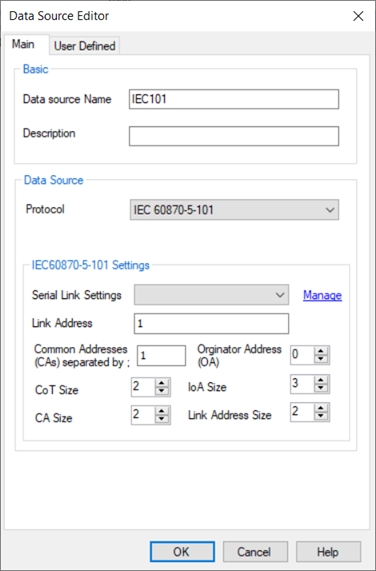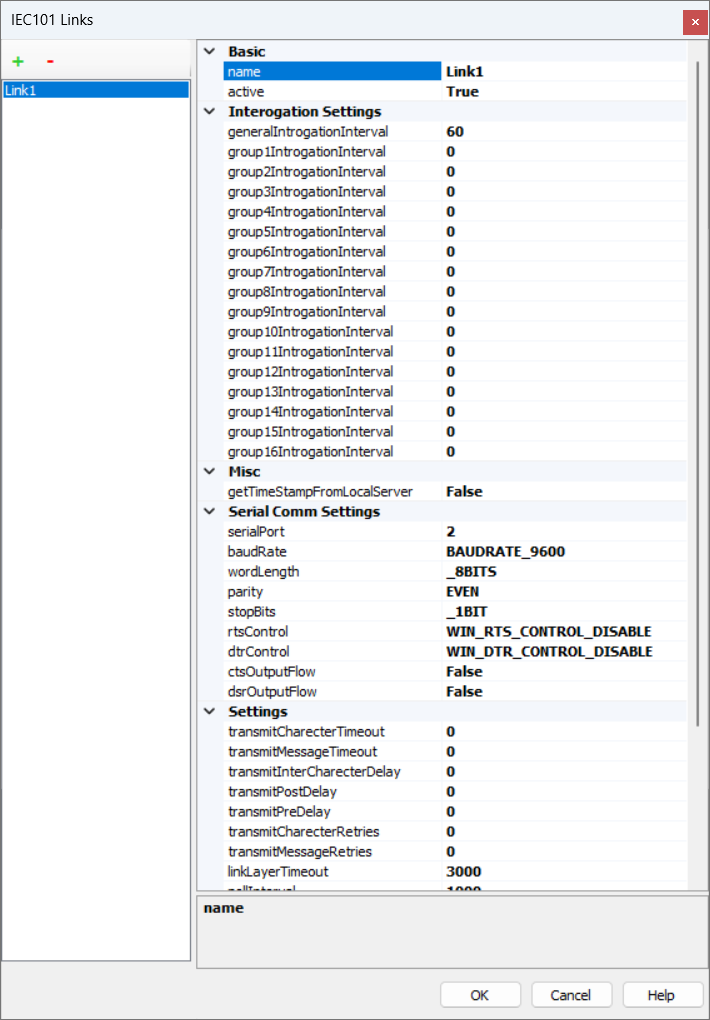IEC60870-5-101
Stream SCADA can be an IEC60870-5-101 Master to any compliant device(slave RTU).
Data Source Configuration
From Stream Explorer, select Data Sources and click on the Add button.

- Multiple data sources can be on the same link, this represents the serial loop with multiple slave RTUs. Each RTU has its unique link address.
- Name: Unique name for the data source.
- Description: Optional information about the data source.
- Protocol: Selecting IEC 60870-5-101 means that Stream SCADA is a Master that will establish serial communications with RTUs (slaves).
- Link Address: Data Link Address of the RTU.
- CoT Size : Cause of Transmission Size, default is 2.
- IoA Size: Information object address size.
Serial Link Settings:
Serial link settings are used to identify the serial loop settings. A serial port must be presented by only one serial link, then all slaves connected on the serial loop will be represented by data sources related to that serial link.

- Basic
Name: enter a suitable name for the serial link that represents the physical serial loop.
Active: If False, the serial Link won’t start.
- Interrogation Settings
Interrogation groups are use to separate the RTU points based on their usage, so each group can have a different interrogation interval.
generalInterrogationInterval: in Sec if 0 , General Interrogation will not send in particular interval, else in particular seconds GI will send to server(RTU).
group1InterrogationInterval: in sec if 0 , group 1 interrogation will not send in particular interval, else in particular seconds group 1 interrogation will send
to server.
..
..
group16InterrogationInterval: in sec if 0 , group 16 interrogation will not send in particular interval, else in particular seconds group 1 interrogation will
send to server.
- Misc
getTimestampFromLocalServer: Boolean flag to overwrite RTU timestamp by stream server local timestamp.
- Serial Comm Settings
serialPort: The serial port number.
baudRate: The serial communication baud rate of the RTU.
wordLength: number of bits in one byte (7 or 8).
Parity: The serial communication parity of the RTU(Even, Odd, None).
stopBits: The serial communication number of stop bits of the RTU(1,2).
rtsControl, ctsControl, dtsOutputFlow, dsrOutputFlow: Based on RTU serial settings.
- Settings
transmitPreDelay: Transmit Delay before send.
transmitPostDelay: Delay after send.
transmitInterCharacterDelay: Delay between characters during send.
transmitCharacterTimeout: Timeout if the character is not being sent.
transmitCharacterRetries: Number of retries to send.
transmitMessageTimeout: Message Timeout if entire message is not sent.
transmitMessageRetriesTransmit: Message Retries to retry the entire message.
linkLayerTimeout: Link Layer timeout in milliseconds.
pollInterval: poll interval in milliseconds.
commandTimeout: Command Timeout (command ack timeout) in milliseconds.
commandResponseActTermUsed: if server Generate ACTTERM in command respond.
clockSynchronizationPeriod: in sec if 0 , clock synchronization will not send in particular interval, else in particular seconds clock synchronization will
send to server.
retryToLoadConfigurationDataDelay: Time delay in milliseconds after which the client/master will reload its configurations.
autoGenerateTags: pending.
viewTraffic: if true, detailed communication Tx,Rx packets are shown in stream server console mode. It’s mainly used for troubleshooting.
updateTagIfTimestampChange: update tags if new timestamp is received from RTU, not only value change.
balancedTransmission: if true, transmission mode is balanced(one to one communication), else it’s unbalanced(multidrop).
Note: You need to install VC++ Redistributable (x86). You'll find it in installation CD (vcredist_x86.exe).
